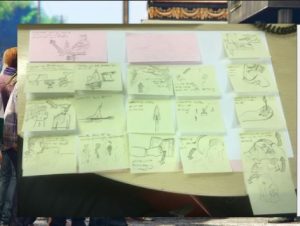In order to understand audience you should understand what makes them tick, especially what reasons they have for consuming media at all. A couple of theorists who considered this were Blumler & Katz, who suggested that there were four reasons collectively known as Uses and Gratification. Their theory describes an active audienceand suggested four reasons for people to actively seek out and consume media:
USES AND GRATIFICATION
| Information | Self education to suit personal needs; advice on practical matters; information on events or issues of personal interest; curiosity or general interest |
| Personal Identity | Media reinforces personal values; models of behavior; content explored to challenge, adjust or affirm sense of self |
| Social Interaction | Identify with others to gain a sense of belonging; find basis for real life interactions; substitute for real life relationships |
| Entertainment | Escape; diversion; emotional release; filling time; aesthetic enjoyment |
Here is a powerpoint on Stuart Hall and his ‘Reception Theory’. Consider what he says about audience. He argues that an audience decodes what the producer encodes in a text. However, how they read the text will depend on their demographics and psychographics and general cultural competence.
Here is the Theory Booklet with all of Hall’s ideas on Pages 11 and 12.
RECEPTION THEORY
TASK
So…what am I supposed to do with all this theory?
Task – Design your perfect audience member.
As a pair/group agree the following features of your audience:
- Which other bands/artists your audience would be into?
- What other media they would consume, fashion tastes, musical genre preferences,
- What are their values, attitudes and beliefs they hold about what’s important in their lives and the world around them.
- What broad groups your audience fall into (gender, age, education, occupation, marital status, cultural background)?
- What ‘communities’ do they belong to?
- Where do they live, work and play?
Then individually design your target audience profile
HELP
Here is a handout we gave you earlier this year which describes different audience groups / communities which is helpful in reaching some conclusions about their values, attitudes and beliefs, and how to describe their communities and social groups.
Use Indesign, or Google slides to design a profile for your target audience which they might upload to a dating site.
Give your ideal audience an image, name, gender, relationship status, groups, status, likes, dislikes…all of this should be through the filter of music and should help describe your audience profile. Make it as detailed as possible – why not consider someone you know (do not actually use them) who likes the music, is a fan of that music/band and use them as inspiration.
Note: Each group member should complete their own ideal fan.
Here are a template that you might want to follow for categories etc: other popular artists liked by fans of X, age, gender, other things liked by (TV, food, sport, online, films, actors, artists etc). It is a very boring example but is a basic outline of what you should be doing.
You should also try and outline the ‘typical fan’ on someone you know – this always helps to guide your design decisions – would he or she like it, respond to it, notice it, enjoy it?
YOU MUST ALSO USE THIS WEBSITE: yougov.co.uk. Go to ratings/entertainment and then search for your artist or a similar one. Then scroll around and down and see what other artists they might like, what else interests them, their age, beliefs, politics etc. and mention it in your introduction or even better, take a snipping tool screen shot of the profile target audience for your performer. For example this link gives information about fans of Adele.
REMEMBER TO USE TERMINOLOGY IN YOUR BLOG POSTS INTRODUCTIONS! –preferred reading, encode, decode, oppositional reading, demographics, psychographics, cultural experience, uses and gratification, target audience, producer, target audience, entertainment, education, social interaction and personal identity, communities, tribes, tribewired, individualists etc from the audience segmentation sheet.




